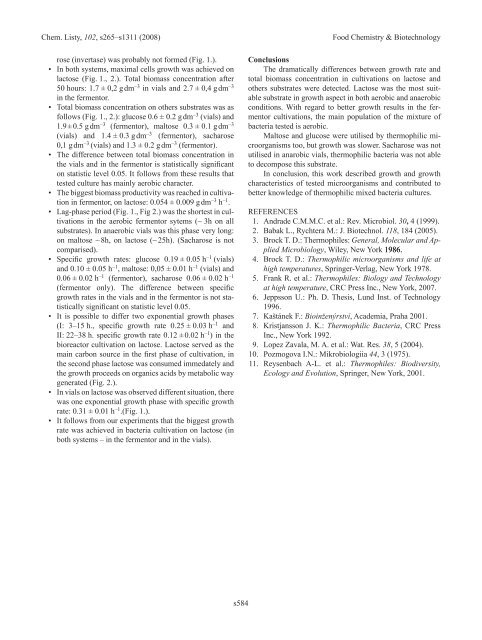3. FOOD ChEMISTRy & bIOTEChNOLOGy 3.1. Lectures
3. FOOD ChEMISTRy & bIOTEChNOLOGy 3.1. Lectures
3. FOOD ChEMISTRy & bIOTEChNOLOGy 3.1. Lectures
Create successful ePaper yourself
Turn your PDF publications into a flip-book with our unique Google optimized e-Paper software.
Chem. Listy, 102, s265–s1311 (2008) Food Chemistry & Biotechnology<br />
•<br />
•<br />
•<br />
•<br />
•<br />
•<br />
•<br />
•<br />
•<br />
rose (invertase) was probably not formed (Fig. 1.).<br />
In both systems, maximal cells growth was achieved on<br />
lactose (Fig. 1., 2.). Total biomass concentration after<br />
50 hours: 1.7 ± 0,2 g dm –3 in vials and 2.7 ± 0,4 g dm –3<br />
in the fermentor.<br />
Total biomass concentration on others substrates was as<br />
follows (Fig. 1., 2.): glucose 0.6 ± 0.2 g dm –3 (vials) and<br />
1.9 ± 0.5 g dm –3 (fermentor), maltose 0.3 ± 0.1 g dm –3<br />
(vials) and 1.4 ± 0.3 g dm –3 (fermentor), sacharose<br />
0,1 g dm –3 (vials) and 1.3 ± 0.2 g dm –3 (fermentor).<br />
The difference between total biomass concentration in<br />
the vials and in the fermentor is statistically significant<br />
on statistic level 0.05. It follows from these results that<br />
tested culture has mainly aerobic character.<br />
The biggest biomass productivity was reached in cultivation<br />
in fermentor, on lactose: 0.054 ± 0.009 g dm –3 h –1 .<br />
Lag-phase period (Fig. 1., Fig 2.) was the shortest in cultivations<br />
in the aerobic fermentor sytems (~ 3h on all<br />
substrates). In anaerobic vials was this phase very long:<br />
on maltose ~ 8h, on lactose (~ 25h). (Sacharose is not<br />
comparised).<br />
Specific growth rates: glucose 0.19 ± 0.05 h –1 (vials)<br />
and 0.10 ± 0.05 h –1 , maltose: 0,05 ± 0.01 h –1 (vials) and<br />
0.06 ± 0.02 h –1 (fermentor), sacharose 0.06 ± 0.02 h –1<br />
(fermentor only). The difference between specific<br />
growth rates in the vials and in the fermentor is not statistically<br />
significant on statistic level 0.05.<br />
It is possible to differ two exponential growth phases<br />
(I: 3–15 h., specific growth rate 0.25 ± 0.03 h –1 and<br />
II: 22–38 h. specific growth rate 0.12 ± 0.02 h –1 ) in the<br />
bioreactor cultivation on lactose. Lactose served as the<br />
main carbon source in the first phase of cultivation, in<br />
the second phase lactose was consumed immedately and<br />
the growth proceeds on organics acids by metabolic way<br />
generated (Fig. 2.).<br />
In vials on lactose was observed different situation, there<br />
was one exponential growth phase with specific growth<br />
rate: 0.31 ± 0.01 h –1 .(Fig. 1.).<br />
It follows from our experiments that the biggest growth<br />
rate was achieved in bacteria cultivation on lactose (in<br />
both systems – in the fermentor and in the vials).<br />
s584<br />
Conclusions<br />
The dramatically differences between growth rate and<br />
total biomass concentration in cultivations on lactose and<br />
others substrates were detected. Lactose was the most suitable<br />
substrate in growth aspect in both aerobic and anaerobic<br />
conditions. With regard to better growth results in the fermentor<br />
cultivations, the main population of the mixture of<br />
bacteria tested is aerobic.<br />
Maltose and glucose were utilised by thermophilic microorganisms<br />
too, but growth was slower. Sacharose was not<br />
utilised in anarobic vials, thermophilic bacteria was not able<br />
to decompose this substrate.<br />
In conclusion, this work described growth and growth<br />
characteristics of tested microorganisms and contributed to<br />
better knowledge of thermophilic mixed bacteria cultures.<br />
REFEREnCES<br />
1. Andrade C.M.M.C. et al.: Rev. Microbiol. 30, 4 (1999).<br />
2. Babak L., Rychtera M.: J. Biotechnol. 118, 184 (2005).<br />
<strong>3.</strong> Brock T. D.: Thermophiles: General, Molecular and Ap-<br />
plied Microbiology, Wiley, new York 1986.<br />
4. Brock T. D.: Thermophilic microorganisms and life at<br />
high temperatures, Springer-Verlag, new York 1978.<br />
5. Frank R. et al.: Thermophiles: Biology and Technology<br />
at high temperature, CRC Press Inc., new York, 2007.<br />
6. Jeppsson U.: Ph. D. Thesis, Lund Inst. of Technology<br />
1996.<br />
7. Kaštánek F.: Bioinženýrství, Academia, Praha 2001.<br />
8. Kristjansson J. K.: Thermophilic Bacteria, CRC Press<br />
Inc., new York 1992.<br />
9. Lopez Zavala, M. A. et al.: Wat. Res. 38, 5 (2004).<br />
10. Pozmogova I.n.: Mikrobiologiia 44, 3 (1975).<br />
11. Reysenbach A-L. et al.: Thermophiles: Biodiversity,<br />
Ecology and Evolution, Springer, new York, 2001.

















